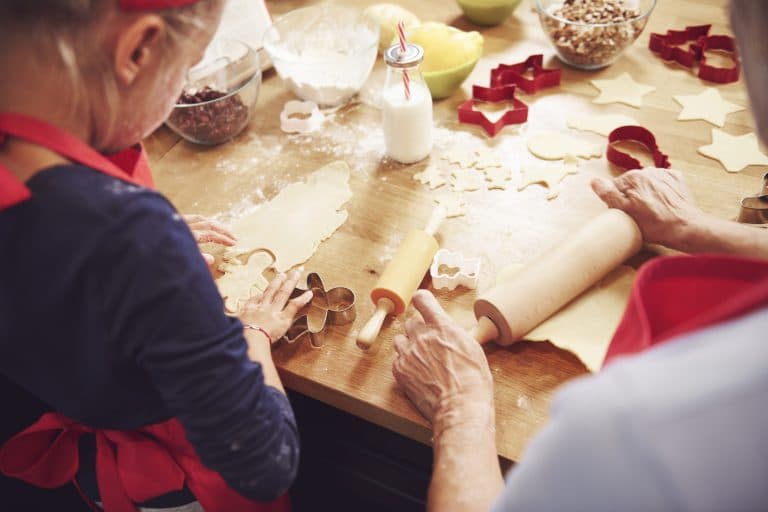Keeping Tradition Alive
12.21.2017 | Heather Cooper

As friends and families gather together to observe winter holidays, many follow traditions as part of their celebrations. There are typical traditions, like lighting a menorah each night of Hanukkah, decorating a tree for Christmas, or making resolutions for the New Year. Some families have more unusual traditions, like having a dress-up theme for Christmas Eve or throwing a BBQ for winter solstice, the shortest day of the year. Some traditions instill faith, but whether faith-based or not, practicing tradition is a way to teach values, build relationships, foster a sense of belonging and create positive memories. These are all things that make a strong positive impact on the life of children.
On The Pulse asked Seattle Children’s Dr. Mollie Grow, pediatrician, and Dr. Tony Woodward, medical director of emergency medicine, to share their top winter holiday traditions.
Carrying on a childhood tradition
When Grow was growing up, her family would take part in the tradition of lighting candles in an Advent wreath each Sunday of December. She does this with her own family now, celebrating one of the themes of hope, peace, joy and love each Sunday in the month.
“We share readings about these values that the kids take turns reading aloud, and then we share something personal to us about each topic,” said Grow. “We really hope to set aside family time together at the end of the busier weekends and have time to reflect on and lift up these values with each other.”
Song and community
Grow’s family also switches up the bedtime routine over the winter holidays by singing holiday carols as their lullabies before bed each night. It’s a way to learn songs and share them with each other.
“Because they have heard the words a lot and know them, our kids tend to join right in with singing the carols in other settings, like while walking Green Lake for the Walk of Lights,” said Grow.
Giving back
Giving is a part of winter celebrations for many, and Grow’s family is no exception. Her children do a gift exchange with their cousins. They learn to find special gifts for one person, sticking to a price limit, and think carefully about what their cousins would want. They also try to find a service project to do together.
“This year we were really excited to do a shift to support a meal packing team that helped prepare 73,000 meals over two days,” said Grow. “The kids learned about how many children may not have enough food to eat in our area, and have asked that we do this again next year.”
Making time and traveling for family
When Woodward’s family moved across the country to work in Seattle 14 years ago, he wanted to ensure that his kids, who were 10 and 7 at the time, stayed close with theirs cousins, aunts, uncles and friends. It was sometimes difficult to sync up schedules, and holiday travel can be expensive and cumbersome, but Woodward’s family found a way to celebrate the holidays with his and his spouse’s large families, often by spreading the celebration out throughout the month. Keeping close relationships despite the distance has been an important tradition for his family, and has enabled them to stay closely connected.
When asked what he thought his kids got out of the tradition of celebrating with family, Woodward said he has seen that his kids, now 24 and 21, “really value their large families and work hard to be available for opportunities to be together. They know the importance of making time for family, valuing relationships and showing others that they care for and are always there for each other.”
Tips for creating or maintaining traditions
As some families are just beginning, or as others are looking for new traditions, here are some suggestions for incorporating traditions into your family.
- Keep it simple. Traditions don’t have to be expensive or take a lot of time. Think of playing games, singing songs, showing gratitude, visiting a holiday display, volunteering, making resolutions or going for a winter hike as a family.
- Fit traditions in at times when you might already have time set aside, like during family time on weekends.
- Involve children in planning and carrying out the activities. The excitement your kids have can motivate you to follow through year after year.
- Reach out to neighbors, the school community or faith-based community to create traditions if you don’t have many family members or if your family lives far away.
- Adapt when needed. Families and friend groups change over time, adding new members through birth and marriage and losing members through distance, death or divorce. Adapt to keep the core of the tradition in place even if the members or location needs to change. If you used to enjoy a big meal at grandma’s house and she’s passed away, do it at your house and use some of grandma’s favorite recipes.
- Traditions aren’t just for young kids. Keep them going through the teen and young adult years.
- Think beyond the holidays. Remember to incorporate traditions and predictable activities into your family life all year long.
It takes effort, but can be so rewarding
Establishing and maintaining family traditions is a way for families to bond together over shared experiences. They connect us to one another and to our past.
“Personally, the rewards of our efforts, while stressful at times, have been well worth the challenges and ensure we regularly connect with those we love,” said Woodward.